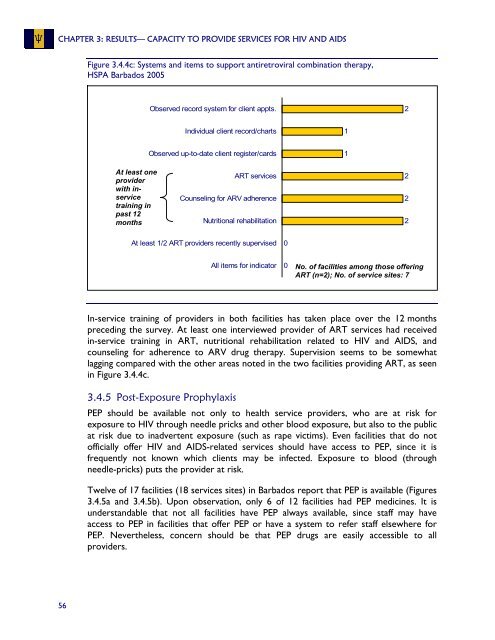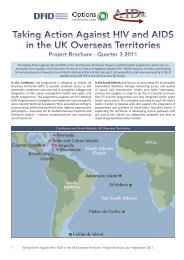Barbados - Carolina Population Center
Barbados - Carolina Population Center
Barbados - Carolina Population Center
You also want an ePaper? Increase the reach of your titles
YUMPU automatically turns print PDFs into web optimized ePapers that Google loves.
CHAPTER 3: RESULTS— CAPACITY TO PROVIDE SERVICES FOR HIV AND AIDS<br />
Figure 3.4.4c: Systems and items to support antiretroviral combination therapy,<br />
HSPA <strong>Barbados</strong> 2005<br />
Observed record system for client appts.<br />
2<br />
Individual client record/charts<br />
1<br />
Observed up-to-date client register/cards<br />
1<br />
At least one<br />
provider<br />
with inservice<br />
training in<br />
past 12<br />
months<br />
ART services<br />
Counseling for ARV adherence<br />
Nutritional rehabilitation<br />
2<br />
2<br />
2<br />
At least 1/2 ART providers recently supervised<br />
0<br />
All items for indicator<br />
0<br />
No. of facilities among those offering<br />
ART (n=2); No. of service sites: 7<br />
In-service training of providers in both facilities has taken place over the 12 months<br />
preceding the survey. At least one interviewed provider of ART services had received<br />
in-service training in ART, nutritional rehabilitation related to HIV and AIDS, and<br />
counseling for adherence to ARV drug therapy. Supervision seems to be somewhat<br />
lagging compared with the other areas noted in the two facilities providing ART, as seen<br />
in Figure 3.4.4c.<br />
3.4.5 Post-Exposure Prophylaxis<br />
PEP should be available not only to health service providers, who are at risk for<br />
exposure to HIV through needle pricks and other blood exposure, but also to the public<br />
at risk due to inadvertent exposure (such as rape victims). Even facilities that do not<br />
officially offer HIV and AIDS-related services should have access to PEP, since it is<br />
frequently not known which clients may be infected. Exposure to blood (through<br />
needle-pricks) puts the provider at risk.<br />
Twelve of 17 facilities (18 services sites) in <strong>Barbados</strong> report that PEP is available (Figures<br />
3.4.5a and 3.4.5b). Upon observation, only 6 of 12 facilities had PEP medicines. It is<br />
understandable that not all facilities have PEP always available, since staff may have<br />
access to PEP in facilities that offer PEP or have a system to refer staff elsewhere for<br />
PEP. Nevertheless, concern should be that PEP drugs are easily accessible to all<br />
providers.<br />
56





